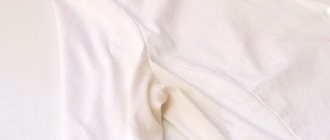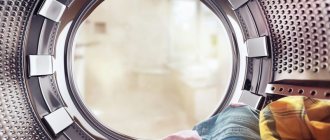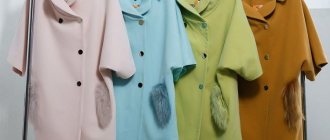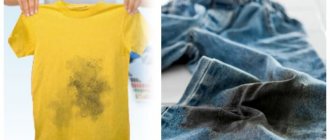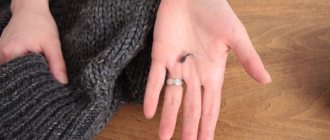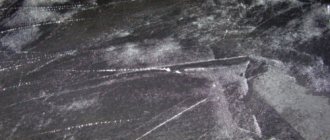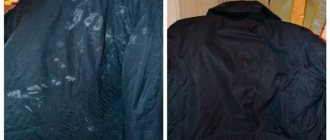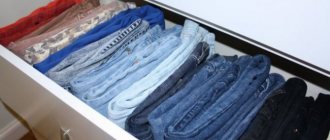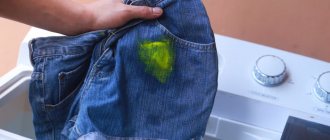06.09.201610.02.2017 Maria Ivanova 2 comments
Have you often encountered this situation: you’re just preparing your favorite thing for release, but you notice disgusting yellow spots on it? In the turmoil, you start looking for a new outfit or rush to wash out stains, but in the end you are late, your mood is ruined, and you are not dressed at all what you wanted.
What are these yellow spots on clothes? Where did they even come from? Why do they appear after washing? How to get them out? Let's find out!
Why do yellow spots appear?
Oddly enough, you will not find an exact answer to this question. There are a lot of reasons for the appearance of yellow spots, so it will be difficult to determine the true culprit of damage to your clothes.
But in order to prevent such “incidents” in the future, you will have to protect your wardrobe from all factors that contribute to the appearance of stains!
Housewives often complain that yellow spots and dots appear on white clothes after washing. But stains, as a rule, cover the entire arsenal of your wardrobe; yellow stains are simply less noticeable on colored and dark tones.
The bed linen has turned yellow, what should I do?
The bed linen has turned yellow, what should I do? First, let's look at why white bedding may turn yellow. We have repeatedly talked about this in our articles, how to restore the whiteness of bed linen - this question is always relevant. So why does the brightness and whiteness of bed linen disappear over time? It depends on the period of use, for example, use bed linen for 20 years, and then wonder why it is yellow?
Seriously, laundry turns yellow not only from age, but also from improper use and storage conditions. So, for example, if you store poorly dried bed linen in an unventilated closet, it will definitely show an unpleasant yellow color.
Yellowness on white PBC may appear as a result of incorrectly selected detergents, for example, in laundry that was poorly rinsed, particles of powder remain that “steal” the whiteness of the bedding set.
Therefore, in order to prevent white linen from turning yellow, it is better to wash it in the machine with an additional rinse. To wash your bed linen less, it is better to have double bed linen with a Euro sheet in stock.
What are the reasons?
- Washing powder. The problem can be both the product itself (when reacting with water) and its concentration. Try changing the powder or using the one you already have in smaller quantities.
- Washing temperature. High temperature provokes many reactions in the microcosm and contributes to the formation and consolidation of existing stains.
- Protein and fat. These are components of your sebum (sebum) that react with tissue to form spots and dots.
- Sweat. The main component of sweat is urea. It forms yellow marks when absorbed by clothing.
Deodorants do not reduce sweating, but only add aroma. At the same time, the cosmetic product itself reacts with sweat, which increases the formation of stains and increases their durability.
- Ironing. When steam ironing, irons can often leave yellow rusty spots, indicating that the water is stagnant and it’s time to wash the iron.
- Bleach. Surprisingly, it can also leave large yellow streaks on clothing. Carefully read the instructions for use of this product before use!
- High water hardness is the cause of stains after washing. Hard water is a result of a high content of metal salts. You can tell that the water in your tap is very hard by the poor foaming of the soap and the deposit of limescale on the kettle or tap.
- High humidity. High humidity may cause stains to appear when storing your wardrobe. Clothes should be thoroughly dried before storing them in the closet, as damp clothing is an ideal environment for mold to form. It is also necessary to sufficiently ventilate/ventilate the room so that the total air humidity in your home and closet does not exceed the norm (40-60%).
Tips for caring for bed linen
Snow-white “decoration” for the bed is a complete hassle. Many housewives think so, because after only 2-3 washes you have to think about how to wash yellowness from bed linen and return the fabric to its impeccable shine.
In fact, the problem can be prevented and it is not difficult if you adhere to the following recommendations:
Washing according to the rules
Don't forget to sort your items before placing them in the washing machine drum. Always wash white and colored sheets separately, even if you are 100% sure that the colored fabric will not fade - the impeccable whiteness of the fabric will be “eaten up” by such proximity. And do not leave dirty bed linen in the basket for a long time - this will quickly turn it yellow.
High-quality rinsing
To protect home textiles from yellowing, they need to be rinsed well after washing. It is advisable to do this first in warm water, then in cool water. For machine washing, you can select the double rinse mode.
Water softening
The fabric turns yellow from regular contact with hard water. To make the water softer, use special detergents with softeners. You can also add baking soda or vinegar when washing and rinsing.
Proper storage
Make sure the bedding is thoroughly dry before storing it in the closet. When wet, laundry turns yellow or gray and acquires an unpleasant damp smell. For the same reason, you should not store snow-white sets in places with high humidity. Try to prevent textiles from caking - regularly take out the laundry to air, and to prevent musty “odors”, cover the bedding with pieces of soap.
You won’t have to figure out how to remove yellowness from bed linen if you get into the habit of soaking snow-white sets before washing. You can add hydrogen peroxide or a couple of drops of fresh lemon juice to the water. Machine washing is even easier - modern devices are equipped with a convenient pre-soak function.
What to do with yellow spots and dots?
If your clothes are already covered in sweat stains, then you shouldn’t give up on them. Your favorite item can still be saved! Let's try to remove the stains!
What will you need?
Look in the kitchen and medicine cabinet, and then decide what from this list you have and what you are ready to use.
- Kitchen soda (or sodium bicarbonate).
- Hydrogen peroxide.
- Vodka.
- Any Fairy type detergent.
- Food vinegar.
- Aspirin, or salicylic acid (acts like acetic or citric acid).
You need to wash the stain first. Cold or tepid water works great.
Why isn't it hot? The protein, which is part of the secretion of the sebaceous and sweat glands, reacts with the salts contained in cosmetics - this gives a yellow color. And hot water denatures the protein (that is, it causes it to coagulate, as when boiling a chicken egg), so the stain penetrates deeply into the fabric, which will prevent it from being removed.
How to remove blood from clothes: remedies for fresh stains
If you find a blood stain, firstly, you should not panic and condemn the items to disposal. Any dirt can be removed if you take the right steps and take the first actions immediately after detecting dirt on the fabric. Then the withdrawal process itself will become easier and faster.
A fresh stain should not cause any particular difficulties; it can be easily removed with any means: laundry soap or washing powder of any brand
The first and basic rule of washing when a blood stain appears on clothes: do not add hot water to the process, otherwise the protein in the composition will coagulate and the stain will turn into ingrained stains. To remove a blood stain from a product made of any type of fabric, you need to fill a basin (or other container) with cold water and add powder. Wash and soak for 40 minutes.
You need to take any washing powder in cold water and soak the product in a basin
Before doing this, you need to get rid of excess liquid on your clothes. This is done with a dry cloth or cotton ball. In no case should you rub the liquid, but remove it with soft touching movements from the fabric.
How to make a makeshift cleaning product?
Regardless of what you find in your kitchen and what product you choose, mix it with warm water in the following ratio:
- baking soda – 3:1;
- hydrogen peroxide – 1:1 (by mixing soda and peroxide you can get a good stain remover);
- vodka – 1:1;
- Fairy type detergent - 1:1;
- food vinegar – 1:1;
- ammonia – 1:1;
- Aspirin - crush 4-5 tablets before dissolving them in water.
The less water you use to dissolve the aspirin, the higher the concentration will be.
What should happen? When you mix the product you choose and warm water, a substance of a certain consistency should form.
- The baking soda will become a paste.
- Hydrogen peroxide, vodka, vinegar, ammonia and aspirin tablets will dissolve.
If the selected ingredient is water-soluble, you will need to prepare a sufficient amount of detergent in advance to completely saturate the area of the stain on the fabric.
Another method: if you don't want to bother with a liquid cleaner, you can mix the resulting substance with a Fairy-type gel detergent.
Removal from clothes: traditional methods
Depending on the type of textile, use different cleaning practices and types of stain removers. But in their absence, home remedies and solutions will help. These include: soda, glycerin, hydrogen peroxide, dishwashing detergent, starch (white things), borax, ammonia.
Taking care of your home textiles, being careful in use, cleaning and chemically treating your belongings on time is a method to avoid problems with the fabric. The utensils will last a long time, will not deteriorate and will retain their original appearance when using distilled water and gentle methods for removing dirt.
How to remove a sweat stain?
Removing sweat stains is possible using products such as:
- liquid cleaner. It should thoroughly saturate the stained area or the contaminated item completely;
- gel or paste detergent. It should be applied in a thick layer and added as it is absorbed;
- fine brush. It won't hurt at all if you rub the stained area on things. You can use any fine brush of medium or low hardness.
Chemistry lesson: You probably remember from school that when soda reacts with acetic acid, carbonic acid is formed (it is unstable, so it quickly breaks down into carbon dioxide and water). That is. at a visible level we observe a rapid release of gas. Therefore, if you add vinegar to a soda solution that has soaked a stain on your laundry, “bubbling” will begin, which will remove the dirt well.
Give the cleaner time! No matter how much you would like to quickly find yourself in your favorite sweater, be patient - you need to leave the cleaning product on for a while (the number of hours depends on the degree and duration of the contamination: the process of discoloration of the yellow spot can take from an hour to half a day).
You can repeat the cleansing procedure many times until the stains on your items are completely removed. It is also possible to combine liquid and paste (gel) cleaners to achieve better results.
Textile upholstery of a sofa: how to wash off blood?
To clean a sofa whose upholstery is made of textiles, professionals use a cheap and effective method - laundry soap.
Regular laundry soap is quite suitable for removing stains.
Pre-treatment of the fabric occurs with cold water: accessible dirt is wiped off with a dampened rag. The movement is the same as when cleaning a mattress: from the edges to the center.
Wash the stain off the upholstery using a regular soap solution, moving from the edges to the center of the stain
Using a clean, damp sponge, completely wash off the foam and traces of laundry soap.
Pre-cleaning is complete; just use a sponge to continue. The maximum amount of laundry soap is applied to it. The stain is rubbed until foam forms, after which the soap is removed with water and a sponge.
To wash off blood from upholstered furniture, you can use special products after pre-treating the stain with an ice cube.
How to remove white spots?
White spots also bring a lot of trouble. Their nature is organic, and they often appear from sweat. As a rule, black and colored clothes are affected.
The removal process is practically no different from that with yellow spots.
- The white stain should be washed in cool water.
- Available remedies include: salt (5 tablespoons per 1 liter of water), vinegar and ammonia in the same proportions as for yellow spots.
- Leave the product on colored and black items for no more than 1-2 hours (due to the instability of the paint and the risk of discoloration).
- It is worth washing things in hot water.
Boiling
This method is only suitable for bedding made from thick cotton or linen fabrics. For boiling, you will need a large enameled or galvanized container, a white cloth, powder or laundry soap, and ammonia.
Cover the bottom of the container with a white cloth and make a soap solution. The previously well-straightened linen is sent to the boiling room and filled with soapy water. If there is severe contamination, add a tablespoon of ammonia. Boil for about an hour, periodically stirring the contents of the “boil” with a wooden stick-tongs.
Boiling helps restore the whiteness of fabric and removes musty odors well. But the method is quite labor-intensive and requires a significant investment of time.
Old sweat stains: what to do with them?
With old spots, everything is almost the same as with yellow spots.
- Unlike what was described earlier, it is necessary to soak contaminated items not just in cool water, but in diluted powder or bleach.
- From the suggested remedies, apply alternately (!) substances in the following combinations: acetic acid + soda, ammonia + lemon juice or Aspirin + hydrogen peroxide.
- Leave the product on things for no more than an hour.
- As standard, washing is required in hot water.
Removing old blood stains: cleaning method
Dried, stubborn dirt requires a little more effort to remove from fabrics. But the main rule also applies: wash only with cold water. In addition to regular soaking, folk practices are used for cleaning. Ammonia, hydrogen peroxide, lemon juice, glycerin and ordinary laundry soap (72%) will help here.
Ammonia has a peculiar smell, but is quite useful for removing stains
A glycerin solution can also be tried on inconspicuous areas of tissue.
Freshly squeezed lemon juice is an excellent folk remedy for removing stains.
If none of the traditional cleaning methods work, then it is important to resort to the help of a strong stain remover. But be wary of them - they can discolor and deteriorate the fabric of the sheet. Pre-treat stubborn dirt with a dry brush. Friction will remove some of it.
How to avoid the appearance of new stains?
- Use quality deodorants and moderate the amount you apply.
- To prevent sweat stains, you can use baby powder on the inside of your clothes.
If you sweat excessively, consult a doctor to rule out local hyperhidrosis.
- Underwear will also help prevent damage to your things by absorbing the “blow” of sweat.
- Don't let sweat stains become old, remove them every time they appear.
Remember: avoiding stains is much easier than removing them!
Don't let yellow stains on your clothes ruin your wardrobe and ruin your life by making you doubt your appearance!
Soda
It is suitable not only as a baking powder. It can be used to remove many types of contaminants. It is especially effective when processing white fabrics. The stains are soaped again with laundry soap, and after an hour they begin machine washing. The laundry is folded into the drum and a teaspoon is poured into it. soda Then washing proceeds as usual.
Digestion
The essence of this method is that the laundry is boiled in water along with bleach or high-quality powder. A large enamel pan is used for this. Baby panties and diapers will whiten in just 25 minutes.
You should not resort to boiling too often (at least once every 5-6 washes), otherwise the fabric fibers will lose strength and tear. Under no circumstances should chlorine bleach be added. Children may have allergic skin reactions. Some washing machine models have a boiling function. The temperature is not higher than + 95 degrees, but this method can be effective.
Vinegar
It works in a similar way. A tablespoon of vinegar is dissolved in a glass of water. Use a cotton pad to wipe off the stains. Within an hour, the acid should remove the yellow marks. It decomposes urea into its constituent components, making it gaseous. Sprinkle soda evenly on top of the stain. Pour 100 ml of hydrogen peroxide into a container with a spray bottle, add a little water and powder. Spray the contamination with this solution. Active foam should appear. After a couple of hours, the laundry is washed and rinsed thoroughly.
Bleaches
It is not recommended to use too aggressive chemicals. Oxygen bleach or Antipyatin soap are perfect for cleaning white items. It is completely safe and made based on a bio-formula. The substances are simply applied to the stains, and after a while they are washed off in the usual way. This way you can wash not only yellow, but also brown stains on white panties.
Note! All of the above methods for removing yellow spots are absolutely harmless for children. And also suitable for women with sensitive skin.

